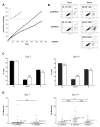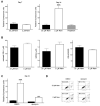Niacin restriction upregulates NADPH oxidase and reactive oxygen species (ROS) in human keratinocytes
- PMID: 17997992
- PMCID: PMC2323356
- DOI: 10.1016/j.freeradbiomed.2007.10.006
Niacin restriction upregulates NADPH oxidase and reactive oxygen species (ROS) in human keratinocytes
Abstract
NAD(+) is a substrate for many enzymes, including poly(ADP-ribose) polymerases and sirtuins, which are involved in fundamental cellular processes including DNA repair, stress responses, signaling, transcription, apoptosis, metabolism, differentiation, chromatin structure, and life span. Because these molecular processes are important early in cancer development, we developed a model to identify critical NAD-dependent pathways potentially important in early skin carcinogenesis. Removal of niacin from the cell culture medium allowed control of intracellular NAD. Unlike many nonimmortalized human cells, HaCaT keratinocytes, which are immortalized and have a mutant p53 and aberrant NF-kB activity, become severely NAD depleted but divide indefinitely under these conditions. Niacin-deficient HaCaTs develop a decreased growth rate due to an increase in apoptotic cells and an arrest in the G(2)/M phase of the cell cycle. Long-term survival mechanisms in niacin-deficient HaCats involve accumulation of reactive oxygen species and increased DNA damage. These alterations result, at least in part, from increased expression and activity of NADPH oxidase, whose downstream effects can be reversed by nicotinamide or NADPH oxidase inhibitors. Our data support the hypothesis that glutamine is a likely alternative energy source during niacin deficiency and we suggest a model for NADPH generation important in ROS production.
Figures




Similar articles
-
NAD in skin: therapeutic approaches for niacin.Curr Pharm Des. 2009;15(1):29-38. doi: 10.2174/138161209787185760. Curr Pharm Des. 2009. PMID: 19149600 Review.
-
NAMPT-derived NAD+ fuels PARP1 to promote skin inflammation through parthanatos cell death.PLoS Biol. 2021 Nov 8;19(11):e3001455. doi: 10.1371/journal.pbio.3001455. eCollection 2021 Nov. PLoS Biol. 2021. PMID: 34748530 Free PMC article.
-
Niacin and carcinogenesis.Nutr Cancer. 2003;46(2):110-8. doi: 10.1207/S15327914NC4602_02. Nutr Cancer. 2003. PMID: 14690785 Review.
-
XPC silencing in normal human keratinocytes triggers metabolic alterations that drive the formation of squamous cell carcinomas.J Clin Invest. 2011 Jan;121(1):195-211. doi: 10.1172/JCI40087. Epub 2010 Dec 1. J Clin Invest. 2011. PMID: 21123941 Free PMC article.
-
Enhanced ROS production and redox signaling with combined arsenite and UVA exposure: contribution of NADPH oxidase.Free Radic Biol Med. 2009 Aug 15;47(4):381-8. doi: 10.1016/j.freeradbiomed.2009.04.034. Epub 2009 May 3. Free Radic Biol Med. 2009. PMID: 19414066 Free PMC article.
Cited by
-
Niacin protects against UVB radiation-induced apoptosis in cultured human skin keratinocytes.Int J Mol Med. 2012 Apr;29(4):593-600. doi: 10.3892/ijmm.2012.886. Epub 2012 Jan 12. Int J Mol Med. 2012. PMID: 22246168 Free PMC article.
-
Cancer Etiology: A Metabolic Disease Originating from Life's Major Evolutionary Transition?Oxid Med Cell Longev. 2019 Oct 8;2019:7831952. doi: 10.1155/2019/7831952. eCollection 2019. Oxid Med Cell Longev. 2019. PMID: 31687086 Free PMC article. Review.
-
Cell growth and homeostasis are disrupted in arabidopsis rns2-2 mutants missing the main vacuolar RNase activity.Ann Bot. 2017 Nov 28;120(6):911-922. doi: 10.1093/aob/mcx099. Ann Bot. 2017. PMID: 28961890 Free PMC article.
-
Mechanistic Insights into the Multiple Functions of Niacinamide: Therapeutic Implications and Cosmeceutical Applications in Functional Skincare Products.Antioxidants (Basel). 2024 Mar 30;13(4):425. doi: 10.3390/antiox13040425. Antioxidants (Basel). 2024. PMID: 38671873 Free PMC article. Review.
-
Hyperthermia induces apoptosis through endoplasmic reticulum and reactive oxygen species in human osteosarcoma cells.Int J Mol Sci. 2014 Sep 29;15(10):17380-95. doi: 10.3390/ijms151017380. Int J Mol Sci. 2014. PMID: 25268613 Free PMC article.
References
-
- Ziegler M. New functions of a long-known molecule. Emerging roles of NAD in cellular signaling. Eur J Biochem. 2000;267:1550–1564. - PubMed
-
- Jacobson MK, Jacobson EL. Discovering new ADP-ribose polymer cycles: protecting the genome and more. Trends Biochem Sci. 1999;24:415–417. - PubMed
-
- Durkacz BW, Omidiji O, Gray DA, Shall S. (ADP-ribose)n participates in DNA excision repair. Nature. 1980;283:593–596. - PubMed
-
- Satoh MS, Lindahl T. Role of poly(ADP-ribose) formation in DNA repair. Nature. 1992;356:356–358. - PubMed
Publication types
MeSH terms
Substances
Grants and funding
LinkOut - more resources
Full Text Sources
Other Literature Sources
Research Materials
Miscellaneous

